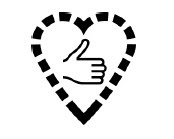Post #26 Social Stories & Articles - Kindness & Being Kind
Kindness & being kind have benefits for physical and mental health. Finding ways to help autistic children and young people to understand these concepts is important for developing positive relationships and for their wellbeing. Social Stories & Articles are an engaging way to teach about kindness.
Social Stories or Articles (for those individuals who feel that stories are immature or are lies because they are not true!) are a useful way of sharing information about kindness & being kind with your child. Social Stories are written carefully and following guidelines provided by Carol Gray, the founder of the approach. This post is not about teaching you how to write a Social Story, but to illustrate how Social Stories can be developed to teach autistic children about kindness. For more information about Social Stories and guidelines for writing, see: Carol Gray - What is a Social Story? or National Autistic Society - Social Stories
The following example of a Social Story illustrates the approach for a young child or an individual at an early stage of development.
 |
| Pictures with permission from Twinkl |
The next example illustrates how a Social Article might be informative and helpful in clarifying concepts.
Kindness is defined in the Cambridge English dictionary as: 1) the quality of being gentle, caring and helpful & 2) a kind action. A thesaurus search identifies a number of alternative words for kindness including: kind-heartedness, benevolence, consideration, compassion, altruism. Hanging out the washing for a parent. Sending an email to a relative. Helping a friend with their homework. Volunteering at a food bank. |
This article includes interests (love of dictionary definitions, thesaurus & using websites) which add motivation. There are many descriptive sentences which use language and vocabulary appropriate for the reader. In addition, examples are included to clarify concepts. Perspective sentences indicate how words and actions can affect another person, aiming to strengthen perspective-taking abilities, i.e. the ability to see something from another person's point of view. This is particularly important as many autistic youngsters can find this challenging. Enhancing perspective-taking abilities can improve the quality of relationships by providing explanations for how/why other people behave and feel in specific circumstances. Directive sentences are used to encourage the individual to commit to trying something - this may be a personal challenge (as in this example in which the individual wants to be part of a campaign) or something that an individual might usually resist, but that either needs to be done or would improve the quality of their relationships. An article like this should be drafted and edited in collaboration with the person you are writing it for.
Social Stories and Articles can be an effective approach, but they do not work by magic! They often require multiple drafts as you share with the individual and they give their feedback. Some individuals may need to read a story or article multiple times. If you son or daughter likes this approach, encourage them to collect their Social Stories or Articles so they can re-read. Facilitate ownership of the stories or articles by encouraging your son or daughter to contribute, e.g., by drawing pictures, researching a topic to add examples and so on. Put time and effort into personalising a story or article as these will be more likely to succeed.
If this approach is of further interest, see posts on preparing your son or daughter for going back to schools, including a 3 part Social Story with symbols.

Comments
Post a Comment